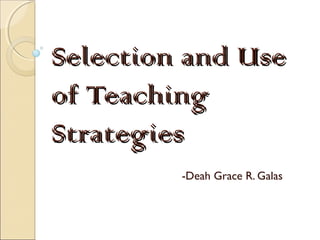Selection and Use of Teaching Strategies
•Descargar como PPT, PDF•
27 recomendaciones•26,583 vistas
1. The document discusses principles for selecting effective teaching strategies, noting that learning is an active process and involving multiple senses maximizes retention. 2. It recommends an integrated approach that incorporates research-based brain-compatible techniques like using memory aids, building neural networks through different levels of learning, and leveraging the brain's strong visual processing capabilities. 3. Effective strategies discussed include involving students in authentic problems, projects, simulations, visuals, songs/mnemonics, hands-on activities, and reviewing material actively. The best method considers the objective, subject matter, learners, teacher, and school policies.
Denunciar
Compartir
Denunciar
Compartir

Recomendados
Recomendados
Más contenido relacionado
La actualidad más candente
La actualidad más candente (20)
Selection & use of teaching strategies & different approaches

Selection & use of teaching strategies & different approaches
Field Study 2 Episode 2 Lesson Objectives As My Guiding Star

Field Study 2 Episode 2 Lesson Objectives As My Guiding Star
Similar a Selection and Use of Teaching Strategies
Similar a Selection and Use of Teaching Strategies (20)
Guidelines in the Selection of Teaching Strategies

Guidelines in the Selection of Teaching Strategies
COGNITIVE DEVELOPMENT (EDUCATIONAL MANAGEMENT).pptx

COGNITIVE DEVELOPMENT (EDUCATIONAL MANAGEMENT).pptx
Último
https://app.box.com/s/7hlvjxjalkrik7fb082xx3jk7xd7liz3TỔNG ÔN TẬP THI VÀO LỚP 10 MÔN TIẾNG ANH NĂM HỌC 2023 - 2024 CÓ ĐÁP ÁN (NGỮ Â...

TỔNG ÔN TẬP THI VÀO LỚP 10 MÔN TIẾNG ANH NĂM HỌC 2023 - 2024 CÓ ĐÁP ÁN (NGỮ Â...Nguyen Thanh Tu Collection
Último (20)
Basic Civil Engineering first year Notes- Chapter 4 Building.pptx

Basic Civil Engineering first year Notes- Chapter 4 Building.pptx
Presentation by Andreas Schleicher Tackling the School Absenteeism Crisis 30 ...

Presentation by Andreas Schleicher Tackling the School Absenteeism Crisis 30 ...
TỔNG ÔN TẬP THI VÀO LỚP 10 MÔN TIẾNG ANH NĂM HỌC 2023 - 2024 CÓ ĐÁP ÁN (NGỮ Â...

TỔNG ÔN TẬP THI VÀO LỚP 10 MÔN TIẾNG ANH NĂM HỌC 2023 - 2024 CÓ ĐÁP ÁN (NGỮ Â...
Energy Resources. ( B. Pharmacy, 1st Year, Sem-II) Natural Resources

Energy Resources. ( B. Pharmacy, 1st Year, Sem-II) Natural Resources
Beyond the EU: DORA and NIS 2 Directive's Global Impact

Beyond the EU: DORA and NIS 2 Directive's Global Impact
Food Chain and Food Web (Ecosystem) EVS, B. Pharmacy 1st Year, Sem-II

Food Chain and Food Web (Ecosystem) EVS, B. Pharmacy 1st Year, Sem-II
Measures of Central Tendency: Mean, Median and Mode

Measures of Central Tendency: Mean, Median and Mode
Mixin Classes in Odoo 17 How to Extend Models Using Mixin Classes

Mixin Classes in Odoo 17 How to Extend Models Using Mixin Classes
Micro-Scholarship, What it is, How can it help me.pdf

Micro-Scholarship, What it is, How can it help me.pdf
Measures of Dispersion and Variability: Range, QD, AD and SD

Measures of Dispersion and Variability: Range, QD, AD and SD
This PowerPoint helps students to consider the concept of infinity.

This PowerPoint helps students to consider the concept of infinity.
Selection and Use of Teaching Strategies
- 1. Selection and UseSelection and Use of Teachingof Teaching StrategiesStrategies -Deah Grace R. Galas
- 2. Guiding Principles in the selectionGuiding Principles in the selection and use of teaching strategiesand use of teaching strategies 1.Learning is an active process What I hear, I forget What I see, I remember What I do , I understand 2. The more senses that are involved in learning, the more and the better the learning.
- 3. Contribution of senses to learningContribution of senses to learning Sight – 75% Hearing – 13% Touch – 6% Taste – 3% Smell – 3%
- 4. 3. Emotion has the power to increase retention and learning. 4. Learning is meaningful when it is connected to student’s everyday life. 5. Good teaching goes beyond recall of information. 6. An integrated teaching approach is far more effective than teaching isolated bits of information
- 5. An Integrated approach incorporatesAn Integrated approach incorporates successful, research-based and brain-basedsuccessful, research-based and brain-based instructional strategiesinstructional strategies 1. Without rehearsal or constant attention, information remains in working memory for only about 15 to 20 seconds. This implies the need for memory aids. 2. Learning is a process of building neural networks. This network is formed through concrete experience, representational or symbolic learning, and abstract learning-the 3 levels of learning.
- 6. 3. Our brains have difficulty comprehending very large numbers because we have nothing in our experience to “hook” them to. 4. The eyes contain nearly 70 percent of the body’s sensory receptors and send millions of signals every second along the optic nerves to the visual processing of the brain. The capacity of the long-term memory for pictures seems almost unlimited.
- 7. 5. There is little doubt that when information is embedded in music or rhyme, its recall is easier than when it is in prose.
- 8. Based-Based StrategiesBased-Based Strategies 1. Involving students in real-life or authentic problem solving. 2. Using projects to increase meaning and motivation. 3. Simulations and role plays as meaning makers. 4. Classroom strategies using visual processing. 5. Songs, jingles, and raps
- 9. 6. Mnemonic strategies 7.Writing strategies 8.Active review 9.Hands-on-activities 10.There is no such thing as best teaching method. The best method is the one that works, the one that yields result.
- 10. FACTORS TO CONSIDER IN THEFACTORS TO CONSIDER IN THE CHOICE OF A TEACHING METHODCHOICE OF A TEACHING METHOD 1. The instructional objective 2. The nature of the subject matter 3. The learner 4. The teacher 5. School policies
- 11. “THE END”
